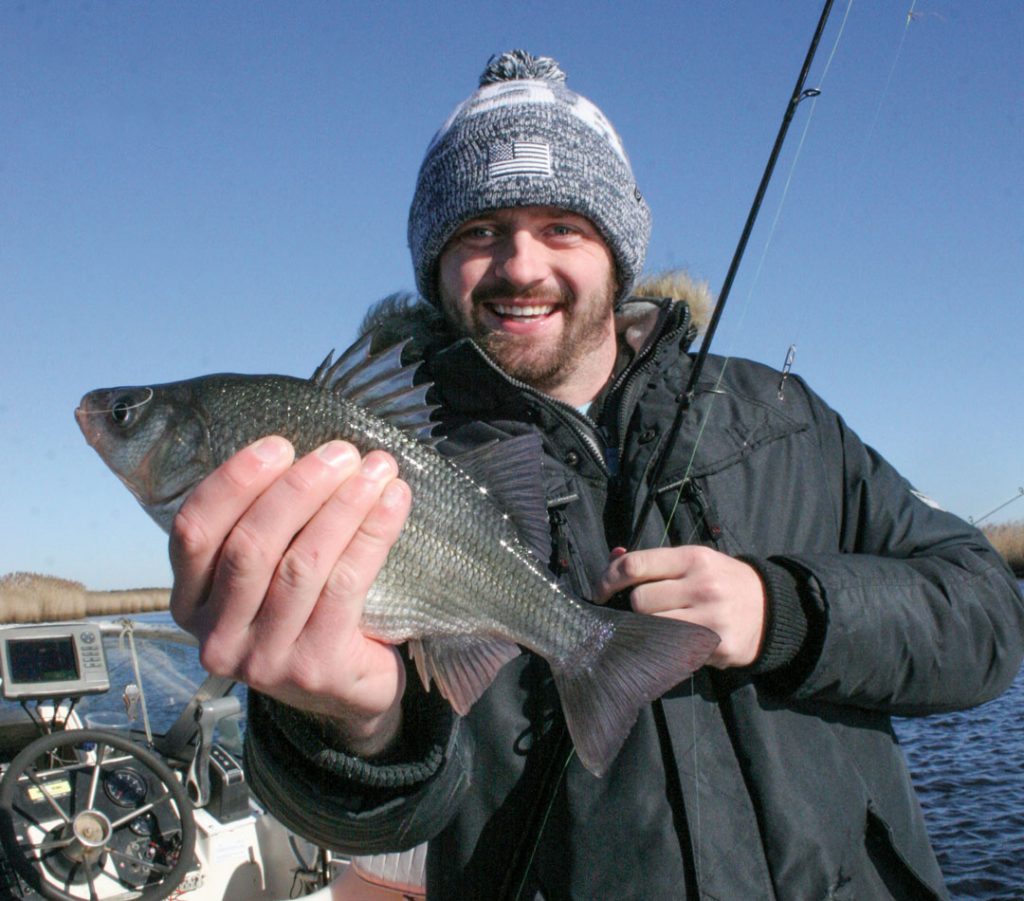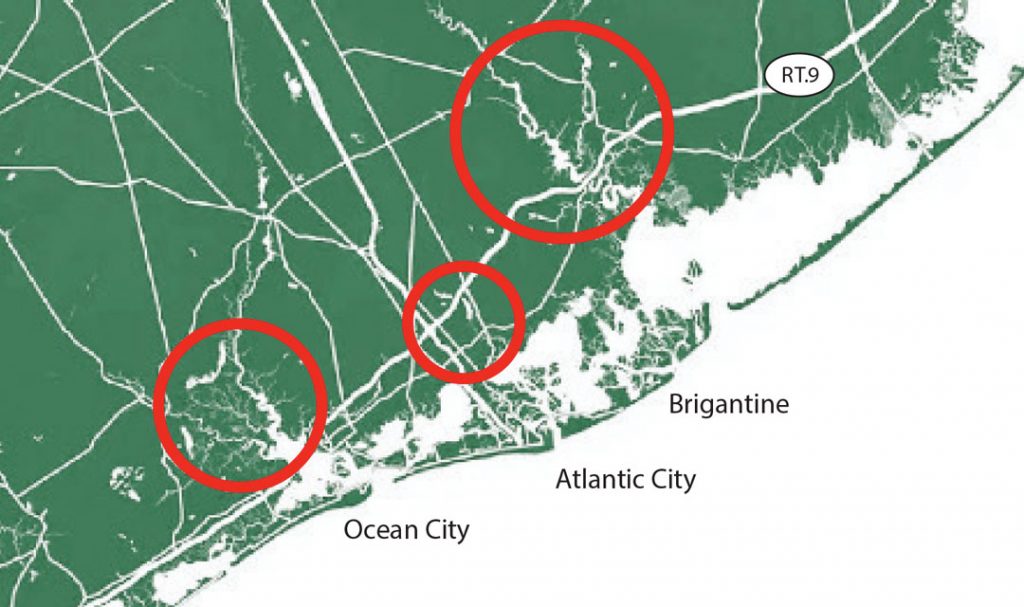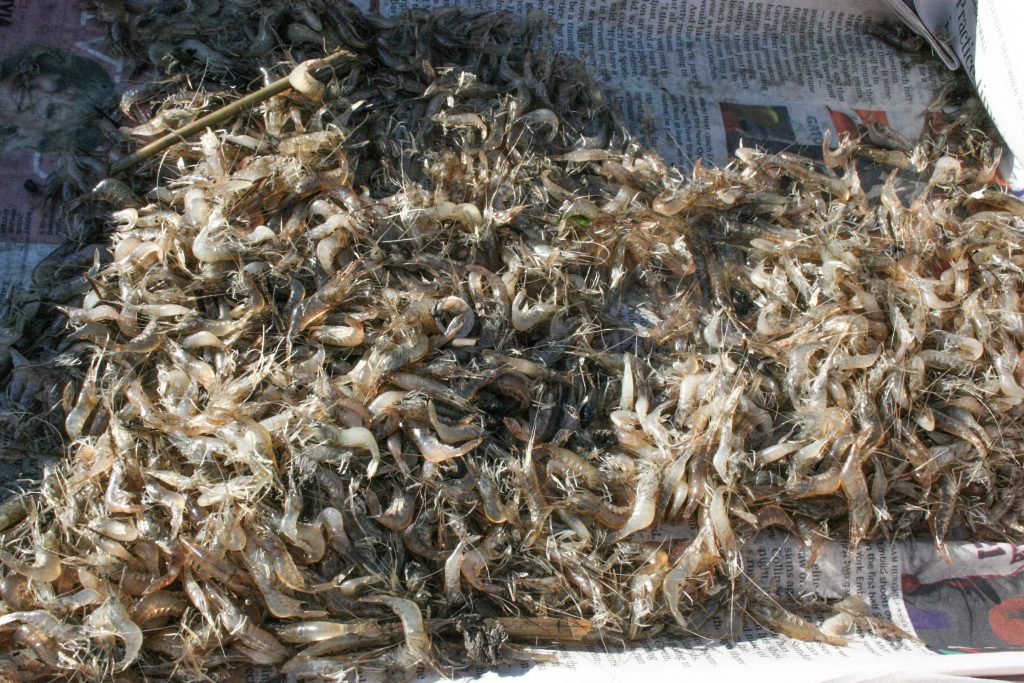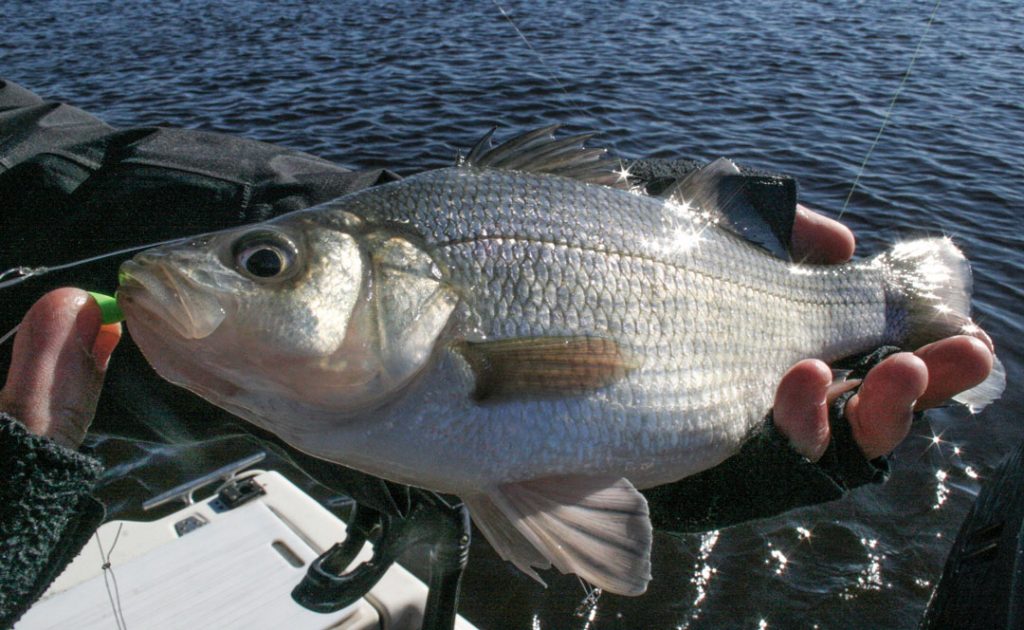Catch White Perch All Winter in New Jersey
South Jersey’s backwaters hold hungry white perch all winter long.

Pictured: While other species vacate the bays when water temperatures drop, white perch turn up the heat on fast winter fishing.
It was cold. Not a little numbness-on-your-fingers cold, but bone-chilling freezing – cold enough for saltwater to ice up the guides of the rods. What was I doing out on the Mullica River in 25-degree air temps with local piney, Dave Showell of the Absecon Bay Sportsman?
Well, like any self-respecting angler, we were fishing when most other anglers had packed up the gear until warmer weather returned. Between weathering the 20-knot winds with frosty faces and hard-iced hands, we absolutely lit up white perch—true fat boys of 1 to 2 pounds, filling the cooler for a wintertime feast. If you’re up to facing the cold, here’s how to load up on these fish in the wintertime.
Finding Winter Perch
There are many facets to understanding winter white perch, starting off with where to fish, along with the tide and times to fish. Generally, the white perch fishery in Jersey revolves around South Jersey, from Toms River to Cape May, with a major concentration in the areas of Absecon Bay, Great Egg River, Mullica River, Cohansey River, and Tuckahoe River systems.

In the winter, perch are most active when the water is between 40 and 48 degrees, though they have been known to feed aggressively even when there is ice on back-bay ponds and brackish back coves. Some anglers even fish through the ice for them with tip-ups and jigs when the ice is “safe enough,” but salt-addled, porous ice is not safe no matter how thick it is.

Any sunny day in the late morning and early afternoon on outgoing waters means perch will be biting better since the sun’s rays have had time to warm up the waters in the shallow, dark mudflats. So, there’s no reason to get up at the crack of dawn. Look for backwater flats that run into channels 3 to 12 feet deep. Look for ledges where perch lie and feed as shrimp, crabs and other forage spills over.

Get Chummy
Perch are group feeders, and the more you attract to the hooks, the more that will arrive seeking forage. Chumming is key to success when white perch fishing, and a flat of grass or sand shrimp make the perfect chum. Dish a handful over the side every minute or so to get the slick flowing.

Showell starts by anchoring up on a ledge that descends into a channel or ascends up onto a flat, then grabs a flat or two of grass shrimp to start the chum slick, tossing out a handful at a time to get a bite going. The key is to keep the slick going. If there is a break of two minutes or so, the perch may fall out of line and follow another path. You can also douse on a few drops of FinEssence shrimp Oil to spread the scent and call in the fish.
Rigs And Baits
A high-low pill-float rig fixed with size 4 to 6 hooks and a 1-ounce bank sinker are standard perch rigs, though 1/16- to 1/8-ounce Spro Phat Fly jigs tipped with proper baits also work when the fish are feeding toward the bottom of the water column.

This rig allows you the chance for a double-header, and also decreases the odds of having your bait stolen. When tied properly, it should remain tangle-free.
Float rigs also succeed when you want to find if the fish are feeding higher or mid-range in the water column. Have a spread of rods set at different depths to see where they are intercepting the slick and react accordingly. Since you are probably chumming with shrimp, they make great baits to start off with. Thread a shrimp on the hook, then ball on three or four more for a shrimp ball bait. Pieces of bloodworms also make great baits – a half-inch piece threaded on the hook with a little bit left to dangle off. You can even opt to use scent-infused Fishbites bloodworms to attract perch. They do stay on the hook through multiple fish nibbles.

FIGHT ON!
White perch hit vigorously, with fire and fury, making for some serious light-tackle fun during the winter months. Since they feed in schools, you may have several rods going off at once, with zipping lines and bending rods all around the boat.
Another option is lighter tackle, such as 6½-foot spinning rods rated for 6- to 12-pounds matched to 3000-class spinning reels, with drags set pretty light but tight enough to turn heads and bring the fish in efficiently. Spool up with 30-pound-test Power Pro braid and tie the rig to the end.

White perch are one of, if not the best-eating fish in New Jersey. Bread these light, flaky fillets with a dusting of flour and Cajun spice, then toss them into a sizzling the frying pan – a purely scrumptious and delectable treat.
In New Jersey salt water, there is no size limit and a 25-fish bag limit on white perch. When keeping some to eat, plan for roughly three fish for each diner. Enjoying them in the middle of winter makes it well worth battling the chill and beating cabin fever.
12 on “Catch White Perch All Winter in New Jersey”
-
mike toomey 4/0 to 6/0 hooks,
Wow they must be largemouth perch.-
John A Breza Where can I fish for white perch without a boat. With success
-
Richard Catalina There are many spots. Anywhere along the upper Mullica River, Bass River or Tuckahoe and any of their tributaries. Look at Google maps and find access points such as boat launches, docks, sod banks, bridges. Having a boat or kayak is best as you can locate the pools and ledges, but my sons and I have done very well from many locations on the banks. As noted in the article, sunny days and outgoing are best. We also throw out Sabiki rigs with 4-5 hooks. Good chance you might also hook catfish if using blood worms or even a non-targeted striper (at least until March 1 and then only with circle hooks). Good luck. (be careful with the catfish, they have spines in their fins).
-
Dave Look at the map they included. The fish move up and down the river depending on how cold it is. Colder water is more salt; warmer water less salt. Find a river and find spots you can access the river on foot. Make a list of these places in order of them up and down the river. If it’s cold out, start near the end of the river. If it’s warm out, start up the river more. Move the opposite direction of where you started. Target holes in the winter. Target mixed areas in the summer.
-
-
Cristian Terreros I was thinking the same thing. Maybe #4 or #6‽
-
Richard Catalina That has to be a misprint. The perch have small mouths and are not large. We use #4 and #6.
-
-
Joe Momma The information in this article about white perch quantity limits in marine waters is inaccurate.
-
Dave 30 lb braid, 4/0 to 6/0 hooks? What the heck are you fishing for? Definitely not white perch.
Nick doesn’t know what he’s talking about. Should have known better than to listen to a guy that wrote a book about drinking the whole night on the beach with smelly clam.
-
Mike O Any guides available in late December early January
-
Mike p When you trying to go I’m on the hunt for them as well
-
-
Bob Haines We fished a couple of days this week and caught a lot of small fish in the upper part of the Mullica from kayaks
-
Jim Nick Is great . But Dam he looks high as a kite ! Lol
Leave a Reply